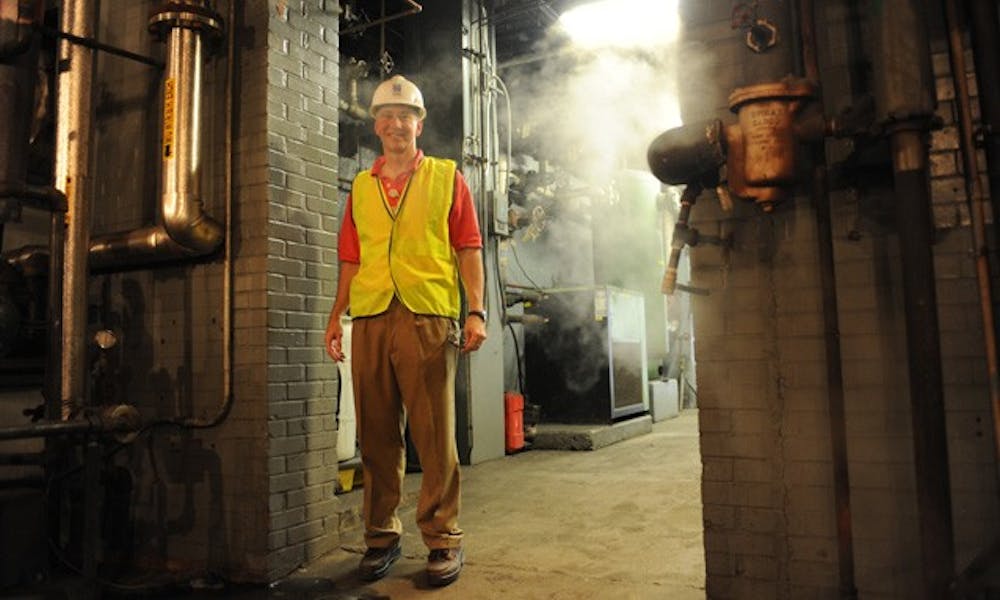Walking down Coal Pile Drive, students were once greeted by a heap of coal that rivaled the height of the nearby Bryan Research Center. Now, the scene is largely dominated by the hustle and bustle of construction: an assortment of loaders, excavators and other machinery looms over workers sporting hard hats and reflective safety vests. Yet, nothing—not even the busyness of construction—can mask the eminent personality missing from this dusty picture.
The legendary coal pile has vanished.
Having burned the last of its coal in April, the West Campus steam plant will now undergo a series of changes to increase its sustainability. The renovations—which began in May and are expected to be completed by October 2012—will transform the coal-burning plant into a natural gas steam plant similar to its East Campus counterpart.
“It is definitely Duke’s... largest step to date reducing our carbon footprint,” said Russell Thompson, director of utilities and engineering for Facilities Management. “We’re doing a lot more than just renovating, we’re completely changing the site.”
Toward a greener future
The $30 million conversion of the West Campus plant continues the University’s push towards carbon neutrality by 2024. The plant currently accounts for 25 percent of the University’s annual carbon output, and converting from coal to natural gas would reduce the plant’s carbon output per pounds of steam by almost half, Thompson said.
After renovations are completed, plant efficiency would also rise from around 80 percent to more than 90 percent—a “really high” number, he added.
The elimination of coal usage and the reduction of greenhouse gas emissions are two of the goals expressed in the University’s Climate Action Plan, issued in 2009. The CAP was developed to fulfill the American College and University Presidents’ Climate Commitment, signed by President Richard Brodhead in 2007, which calls for a regular inventory of emissions and the integration of sustainability into Duke’s educational offerings.
“I think [these changes] just show that Duke is serious about the greenhouse gas issue and wants to do what they can within their span of control to address the issue,” said John Noonan, associate vice president of Facilities Management.
Efforts to address the greenhouse gas issue may help qualify the West steam plant for a Leadership in Energy and Environmental Design designation.
“We’re real confident on the [LEED] silver [rating],” Thompson said, adding that the steam plant may even earn a gold rating.
Step by step
Built in 1929, the West Campus steam plant has served the University’s needs for over 80 years.
The plant currently has three coal-burning boilers, two backup number 2 fuel oil boilers and a sixth boiler that can burn either oil or natural gas, Thompson noted. Ultimately, the three existing coal boilers will be replaced with boilers that can burn either oil or natural gas
The boilers heat water to generate steam, which is distributed through more than 30 miles of underground pipeline to various buildings around campus. It is used to heat buildings and water, sterilize equipment and dehumidify research labs and health system buildings.
However, the steam plant’s constant use presents inherent difficulties, Noonan wrote in an email.
“Working on a renovation like this is very challenging especially because the West plant needs to remain operational [and] producing steam during the renovation,” he said. “Therefore, the planning, logistics, design and construction all need to factor this in.”
For instance, Facilities Management initiated the renovation over the summer, when hot temperatures and low student population on campus keep steam demand lower.
Executive Vice President Tallman Trask wrote in an email that the renovations will also generate “pedestrian improvements” and result in a “very nice landscaped walkway from CIEMAS to Erwin Road.” The new walkway will help integrate the plant, which is unknown to many students, more fully into campus life.
Yet, the most striking changes in the plant’s metamorphosis may be those that occur to the building itself. The steam plant will be refurbished both internally and externally and will display its original 1929 red brick facade to the public next Fall.
“[The West plant] will go from probably one of the ugliest places on campus to one of the most beautiful places on campus,” Thompson said.
Get The Chronicle straight to your inbox
Signup for our weekly newsletter. Cancel at any time.

